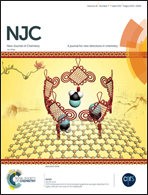Quantum mechanical investigation of G-quartet systems of DNA†
Abstract
The G-quartet systems of DNA have been studied with a reliable quantum mechanical (QM) approach for the optimized monomeric and dimeric structures. Calculations on two Quadruplex systems, using the same QM method, but without optimization of the geometry, were performed for the first time to test the possibility of transferring, at least qualitatively, the results of the dimers in this essential biological system. Some essential properties (optimized geometries, energies and atomic charges) have been computed and discussed. To describe qualitatively and quantitatively the behavior of such systems, we have summarized these properties in the electric field and found that these kinds of systems have two different types of cavity: one where the minimum of the electric field is in the center and the other where this minimum is in one of the guanine planes. The addition of K+ or Na+ cations has been performed for one dimer and the importance of the optimization of the guanine planes was tested. Two stable positions of the cation are found for both the ions without this optimization; when the optimization of the guanines is considered, there is a stable position of the cation in the center of the cavity for the system with K+ and two stable positions of the cation for the system with the Na+, both inside the cavity and with a very small barrier.



 Please wait while we load your content...
Please wait while we load your content...